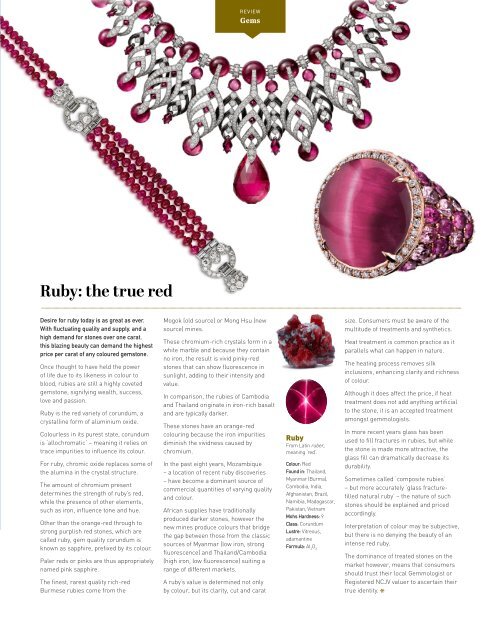Jeweller - June, Edition II 2020
• Shock value: How jewellers can adapt to and even benefit from the impact of COVID-19 • Brave new world: Preparing your business for the 'next normal' of retail • Double or nothing: experts reveal the key strategies to securing multiple-item sales
• Shock value: How jewellers can adapt to and even benefit from the impact of COVID-19
• Brave new world: Preparing your business for the 'next normal' of retail
• Double or nothing: experts reveal the key strategies to securing multiple-item sales
Create successful ePaper yourself
Turn your PDF publications into a flip-book with our unique Google optimized e-Paper software.
REVIEW<br />
Gems<br />
Ruby: the true red<br />
Desire for ruby today is as great as ever.<br />
With fluctuating quality and supply, and a<br />
high demand for stones over one carat,<br />
this blazing beauty can demand the highest<br />
price per carat of any coloured gemstone.<br />
Once thought to have held the power<br />
of life due to its likeness in colour to<br />
blood, rubies are still a highly coveted<br />
gemstone, signifying wealth, success,<br />
love and passion.<br />
Ruby is the red variety of corundum, a<br />
crystalline form of aluminium oxide.<br />
Colourless in its purest state, corundum<br />
is ‘allochromatic’ – meaning it relies on<br />
trace impurities to influence its colour.<br />
For ruby, chromic oxide replaces some of<br />
the alumina in the crystal structure.<br />
The amount of chromium present<br />
determines the strength of ruby’s red,<br />
while the presence of other elements,<br />
such as iron, influence tone and hue.<br />
Other than the orange-red through to<br />
strong purplish red stones, which are<br />
called ruby, gem quality corundum is<br />
known as sapphire, prefixed by its colour.<br />
Paler reds or pinks are thus appropriately<br />
named pink sapphire.<br />
The finest, rarest quality rich-red<br />
Burmese rubies come from the<br />
Mogok (old source) or Mong Hsu (new<br />
source) mines.<br />
These chromium-rich crystals form in a<br />
white marble and because they contain<br />
no iron, the result is vivid pinky-red<br />
stones that can show fluorescence in<br />
sunlight, adding to their intensity and<br />
value.<br />
In comparison, the rubies of Cambodia<br />
and Thailand originate in iron-rich basalt<br />
and are typically darker.<br />
These stones have an orange-red<br />
colouring because the iron impurities<br />
diminish the vividness caused by<br />
chromium.<br />
In the past eight years, Mozambique<br />
– a location of recent ruby discoveries<br />
– have become a dominant source of<br />
commercial quantities of varying quality<br />
and colour.<br />
African supplies have traditionally<br />
produced darker stones, however the<br />
new mines produce colours that bridge<br />
the gap between those from the classic<br />
sources of Myanmar (low iron, strong<br />
fluorescence) and Thailand/Cambodia<br />
(high iron, low fluorescence) suiting a<br />
range of different markets.<br />
A ruby’s value is determined not only<br />
by colour, but its clarity, cut and carat<br />
Ruby<br />
From Latin ruber,<br />
meaning ‘red’.<br />
Colour: Red<br />
Found in: Thailand,<br />
Myanmar (Burma),<br />
Cambodia, India,<br />
Afghanistan, Brazil,<br />
Namibia, Madagascar,<br />
Pakistan, Vietnam<br />
Mohs Hardness: 9<br />
Class: Corundum<br />
Lustre: Vitreous,<br />
adamantine<br />
Formula: AI 2<br />
O 3<br />
size. Consumers must be aware of the<br />
multitude of treatments and synthetics.<br />
Heat treatment is common practice as it<br />
parallels what can happen in nature.<br />
The heating process removes silk<br />
inclusions, enhancing clarity and richness<br />
of colour.<br />
Although it does affect the price, if heat<br />
treatment does not add anything artificial<br />
to the stone, it is an accepted treatment<br />
amongst gemmologists.<br />
In more recent years glass has been<br />
used to fill fractures in rubies, but while<br />
the stone is made more attractive, the<br />
glass fill can dramatically decrease its<br />
durability.<br />
Sometimes called ‘composite rubies’<br />
– but more accurately ‘glass fracturefilled<br />
natural ruby’ – the nature of such<br />
stones should be explained and priced<br />
accordingly.<br />
Interpretation of colour may be subjective,<br />
but there is no denying the beauty of an<br />
intense red ruby.<br />
The dominance of treated stones on the<br />
market however, means that consumers<br />
should trust their local Gemmologist or<br />
Registered NCJV valuer to ascertain their<br />
true identity.


















